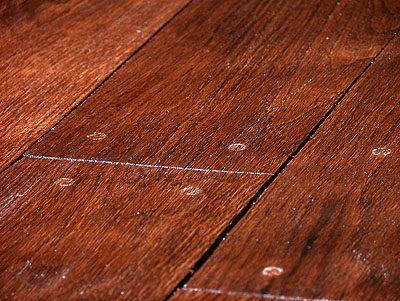WITH the spread of Anglo-mania, smooth, bare floors, in early English style, have grown more and more popular, and wealthy men pay more dollars per square foot than I care to specify, for rosewood, mahogany, West India cherry, and antique oak floors, solid, not veneered. And yet, with all this lavish expense, there are few of them more beautiful than some which might have been seen in old Virginia houses, floors of native oak or forest pine, conscientiously put together by a country carpenter, and polished, year after year, with the ” dry-rubbin’-bresh,” well waxed. Many were satisfied with the native beauty of the wood thus polished, but others used stains, and there was much friendly rivalry among neighboring housekeepers, as to the relative merits of their floors.
At one old homestead, the hall and parlor floors were a dark red color like old mahogany; floors on which the visitor involuntarily hesitated to tread. The secret of their dye was known only to the stately Negro majordomo and his mistress, nor was it until the latter lay on her death-bed that she divulged it. In one corner of the plantation was a peculiar red mud, and this, mixed in hickory lye, was applied to the floors, allowed to dry, then rubbed off and the boards polished. This process repeated again and again, year after year, gave the rare rich hue to the old floors. In another old homestead every floor in summer, except those of the bedrooms, which were covered with matting, was left bare, and even an expert would have been sure they were yellow oak, yet they were only pine. Here the mistress made no secret of her method. Strong lye leached from oak and hickory ashes, applied boiling hot, and followed by wax and rubbing.
I remember one especially beautiful floor which was the fruit of invention stimulated by dire necessity. The family moved during the war into a house, in which the parlor floor had become badly weather-stained.
A parlor carpet in those days was as unattainable as a roc’s eggs, so there was naught left but to stain the floor, and the stain to be effective must be dark. A strong decoction of chestnut oak bark was applied three times, boiling hot, plank by plank, each time being well rubbed in and suffered to dry. Finally comes the wax and polishing with the brush, this last repeated three or four times every week. Each summer the bark dye was renewed in one application, and in a few years the floor looked like highly polished black walnut, and passing across it you might plainly see your shadow reflected in the wood

